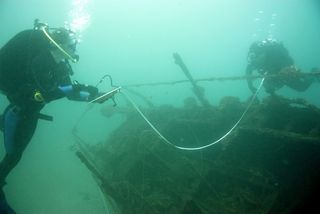
Divers Explore WWII Shipwrecks, Sunken Aircraft

Scuba-diving scientists this week explored sunken World War II-era shipwrecks and aircraft along the southern coast of the Hawaiian island of Maui.
The survey team produced scaled drawings and took photographs of six wreck sites, including a carrier-based dive bomber (SB2C-1C Helldiver); a carrier-based fighter plane (F6F Hellcat); and three amphibious assault vehicles (LVT-4 and LVTA-4s), two with mounted 75mm howitzers. The documentation is used to evaluate wrecks for deterioration and helps with identification when artifacts have been moved or go missing.
The two-week survey was led by the National Oceanic and Atmospheric (NOAA) and the University of Hawaii. The exploration allowed students from the University of Hawaii to get hands-on training surveying shipwrecks on the bottom of the ocean.

During World War II, before major invasions in the Pacific, U.S. Marine Corps and Army personnel trained in landing craft and assault vehicles along Maui's southern coast from Maalaea Harbor to Ahihi Bay. Overhead, aircraft from the Puunene Naval Air Station on Maui conducted combat practice runs. Amphibious operations and naval aviation proved to be two critical innovations of World War II that ultimately helped the United States triumph in the Pacific.
Developing these tactics was dangerous, and many planes and landing craft, and occasionally the lives of servicemen, were lost around the islands. Today, the legacy of that period can be found in near-shore waters, where sunken aircraft and shipwrecks provide recreational diving sites, as well as habitat for marine species.
The remains of an SB2C-1C Helldiver carrier-based dive-bomber rest on the seafloor off the Maui coast. CREDIT: NOAA/University of Hawaii.
"The wrecks along the coast are like windows into the past and they remind us of the sacrifices made during World War II," said Hans Van Tilburg, NOAA's maritime heritage coordinator. "The information collected during this project will help us better understand this chapter in our history and its significance to the Pacific."
Sign up for the Live Science daily newsletter now
Get the world’s most fascinating discoveries delivered straight to your inbox.
For now, details surrounding the sinking of the assault vehicles near Makena, Maui, and the specific identity of the F6F Hellcat, remain mysteries pending further research. Details will be posted on the project's website as they are available.

